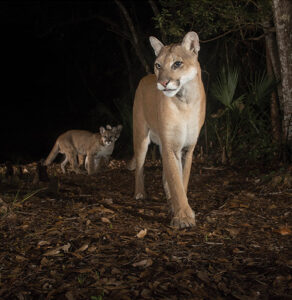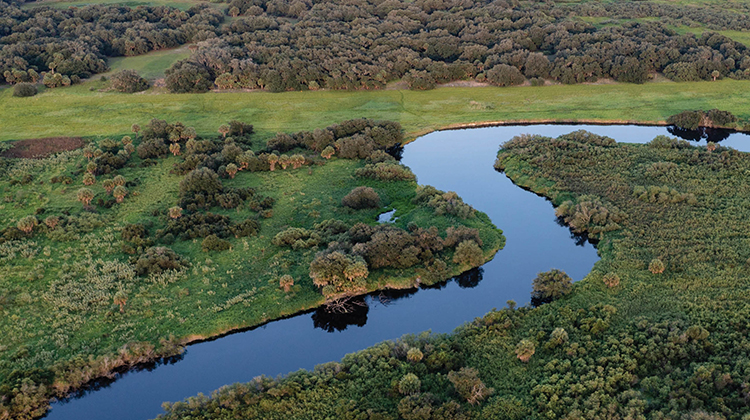By Christy Swift
Photography by Carlton Ward
A hundred acres sounds like a lot of land, but when it comes to animal habitats and conservation, it’s just a drop in the proverbial bucket. Florida is growing (over 200,000 new residents joined our state from 2020 to 2021, according to census data), and it’s unlikely to stop. But how can we grow without losing what we love most about this state— our open spaces, our healthy waterways, our wildlife and their habitats, the “Old Florida” that’s so close to our hearts?
According to photographer and conservationist Carlton Ward, Jr, we can start by preserving the Florida wildlife corridor.
What is the Florida Wildlife Corridor?
The Florida wildlife corridor is an interconnected network of green spaces spanning the state. It includes forests, wetlands, fields, pastures, timberlands and even fringes of the suburbs. These areas are crucial habitats for Florida’s rich wildlife populations, such as Florida panthers, black bears, alligators, otters and many species of birds. It’s not just about acreage, either. It’s about keeping these areas connected so that migrating species can move between them rather than allowing development to segment them into conservation “islands.” The limited biodiversity that occurs when this happens endangers these animals.


“Panthers used to live throughout the entire eastern United States,” Ward explains. “Through persecution and hunting and habitat loss over the previous century, they were wiped out everywhere east of the Mississippi River except on the southern tip of Florida because the Everglades were so wild and remote, nobody wanted to develop them. It was the last refuge for the panther.”
“Since then, the panther numbers dropped down to only 20 or fewer in the 70s and 80s, and they were so inbred they were having problems. The males were infertile. They were having physical health abnormalities. Holes in their hearts. Kinked tails. That decreases health and is a fast track to local extinction. We’re trying to avoid that with other animals elsewhere. Turkey, deer, bobcat, bear, panther— they have to have enough territory to have enough numbers to be genetically viable,” Ward explains.

The Florida Wildlife Corridor Act
The concept of a Florida wildlife corridor was founded back in 2010 by a group of conservation- minded partners from both government and private organizations, including the Nature Conservancy, Audubon of Florida, Defenders of Wildlife, Archbold Biological Station, and the Florida Fish & Wildlife Conservation Commission.
Ward and many others, including Florida Wildlife Corridor executive director and CEO Mallory Lykes Dimmitt worked hard to get the corridor concept in front of lawmakers, and last summer their work paid off. Legislation was passed formally recognizing the corridor, and the Florida Wildlife Corridor Act was signed by Governor Ron DeSantis on June 29th, 2021. Support for the Act was unanimous, something that’s difficult to achieve in our current polarized political climate.
“The landmark passage of the Florida Wildlife Corridor Act officially designated the Florida Wildlife Corridor as a priority area and shined a spotlight on its importance, and we will build on this momentum to continue conserving the Corridor,” Dimmitt said in a press release.


The First “New” Additions to “Old” Florida
While the Act itself did not have any dollars attached to it, the legislature also immediately allocated $300 million in federal economic stimulus funds to wildlife conservation in addition to the $100 million that was already in place via the Florida Forever conservation program.
So far, as a result, six new conservation areas in the corridor have been established. Ward has visited almost all of them.

Hardee Flatwoods
This privately owned 1,661-acre property is a tract of land in eastern Hardee County bordering the Highlands County Sun ‘n Lake Preserve. It contains a mix of flatwoods, hammock, and improved pasture with wetlands throughout, and houses a small cattle operation.
“It’s cool because in eastern Hardee county, there’s been very little conservation easement activity on private land. This property is on the headwaters of Charlie Creek, part of the Peace River watershed, and supports a whole range of species,” Ward says.

Devil’s Garden
This property, owned by Alico, Inc., is located in Hendry county and consists of two non-contiguous parcels totaling 1,638 acres. According to the legislative minutes, “Both the northern 896-acre parcel and the southern 742-acre parcel share the majority of its boundary with the Okaloacoochee Slough Wildlife Management Area and the Okaloacoochee Slough State Forest. Serving as a primary and secondary zone for the federally endangered Florida panther, numerous records of panther use, as well as other rare and threatened plants and animals, have been noted throughout the subject property.”

Coastal Headwaters Longleaf
This is a 2,115-acre piece of working pine forest adjacent to the Blackwater River State Forest in Santa Rosa county in the Florida panhandle. According to the minutes, preservation of this property will help restore longleaf forests, one of the most threatened and ecologically diverse ecosystems in the world; allow for more recreational opportunities; provide for better prescribed fire management; and protect the drinking water in Santa Rosa County.
Ward notes that this conservation effort was achieved after a lot of hard work by the Conservation Fund working with the Department of Environmental Protection using resources from the U.S. Forest Service. “Sometimes it’s state and federal partnerships that get the job done,” he says.

Corrigan Ranch
This parcel is 4,381 acres of the Corrigan Family ranch located in Okeechobee county and acts as an extension of the Kissimmee Prairie State Preserve. Ward says the Florida Conservation Group partnered with Common Ground Ecology to help make this happen. Ward also notes that this area is home to the Florida grasshopper sparrow, the most endangered bird in North America, which relies on rare dry prairie habitat.

Wedgeworth Ranch
Spanning Indian River and Okeechobee counties, this 6,665-acre parcel is part of Wedgeworth Farms, a working cattle ranch, located south of Yeehaw Junction. It is located within the Kissimmee-St. Johns River Connector Florida Forever project and represents the two biggest watersheds in the area. According to the cabinet minutes, “This area is important for the Florida grasshopper sparrow, sandhill crane, mottled duck, wood stork, crested caracara, and other imperiled wildlife species.”

Cow Creek Ranch
These 3,279 acres in Okeechobee County belong to the Larson family, who span 75 years and three generations of ranching in Florida. Rancher and naturalist Woody Larson purchased it primarily as conservation land, and secondarily to use as a working cattle ranch. It is part of the St. Lucie River Estuary basin and contains cypress swamps, mixed hardwood forests, and pastureland. Both of its creek systems empty into drainage canals that flow into the North St. Lucie River.
Larson has seen many game species on the property, including white-tailed deer, wild hogs, turkey, and quail. He’s also seen wood storks, rose spoonbills and bald eagles. His son and co-owner of the property, Travis Barton, has captured footage of panthers on his game cameras. Some of their neighbors hope to earn conservation easements as well, Larson says, which will help to further insulate the corridor.
“I’m really pleased that our legislature is looking at funding more conservation easements,” says Larson. “I think if Florida is going to remain what we remember and what we think of as Florida, we need to protect these areas.”

It’s A Good Start
Saving “Old” Florida seems to be one issue that transcends political ideology. No matter whom we vote for, most of us love this state and don’t want it to lose its natural, wild beauty.
“Florida’s landscape is unique and diverse – we continue to put the puzzle pieces in place to conserve lands that protect our water and provide wildlife habitat and outdoor public recreation,” said Department of Environmental Protection Director of State Lands Callie DeHaven in a press release. “We feel especially fortunate to be working with passionate and dedicated partners to make these important purchases and look forward to continuing our commitment – together.”
But there’s more work to be done. The Florida cabinet will be looking at adding more conservation easements to the list in their next meeting on March 29, 2022. Heartland Living will be following up to see what those will look like.
In the meantime, to learn more about the Florida Wildlife Corridor and how you can help support it, visit floridawildlifecorridor.org.





